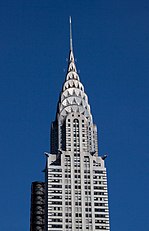Art deco
Left to right, top to bottom: Grand Rex movie theatre in Paris (1932), Cassandre poster for ocean liner SS Normandie (1935), salon of Paul Reynaud in Paris (1934), Chrysler Building in New York City (1930) and hood ornament "Victoire" by René Lalique (1928)
|
|||||||
| Years active | 1910-1939 | ||||||
|---|---|---|---|---|---|---|---|
Art Deco (/ˌɑːrt ˈdɛkoʊ/), or Deco, is a style of visual arts, architecture and design that first appeared in France just before World War I. It became popular in the 1920s and 1930s, and influenced the design of buildings, furniture, jewellery, fashion, cars, movie theatres, trains, ocean liners, and everyday objects such as radios and vacuum cleaners. It took its name, short for Arts Décoratifs, from the Exposition Internationale des Arts Décoratifs et Industriels Modernes (International Exhibition of Modern Decorative and Industrial Arts) held in Paris in 1925. It combined modernist styles with fine craftsmanship and rich materials. During its heyday, Art Deco represented luxury, glamour, exuberance, and faith in social and technological progress.
Art Deco was a pastiche of many different styles, sometimes contradictory, united by a desire to be modern. From its outset, Art Deco was influenced by the bold geometric forms of Cubism; the bright colors of Fauvism and of the Ballets Russes; and the updated craftsmanship of the furniture of the eras of Louis Philippe and Louis XVI; by the exotic styles of China and Japan, India, Persia, ancient Egypt and Maya art. It featured rare and expensive materials such as ebony and ivory and exquisite craftsmanship. The Chrysler Building and other skyscrapers of New York were the most visible monuments of the new style. In the 1930s, after the Great Depression, the style became more subdued. New materials arrived, including chrome plating, stainless steel and plastic. A more sleek form of the style, called Streamline Moderne, appeared in the 1930s; it featured curving forms and smooth, polished surfaces. Art Deco became one of the first truly international architectural styles, with examples found in European cities, the United States, Russia, Latin America, Africa and Asia. The style came to an end with the beginning of World War II. Deco was replaced as the dominant global style by the strictly functional and unadorned styles of modernism and the International Style of architecture.
...
Wikipedia





